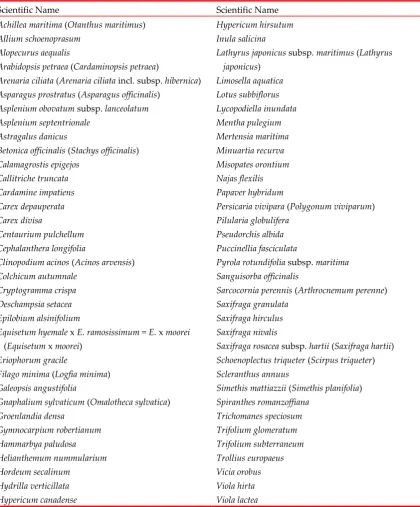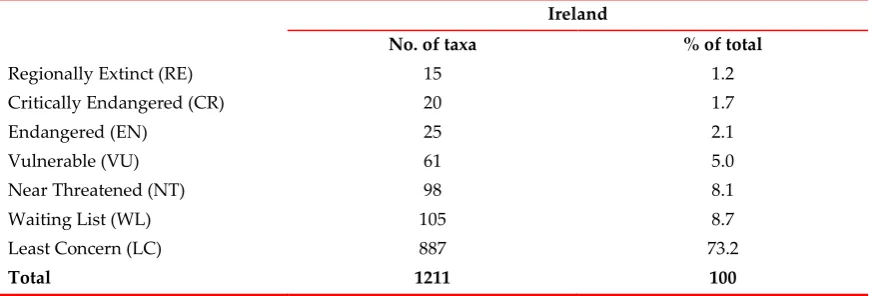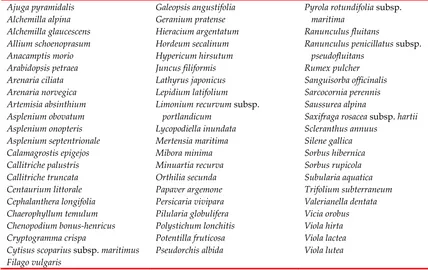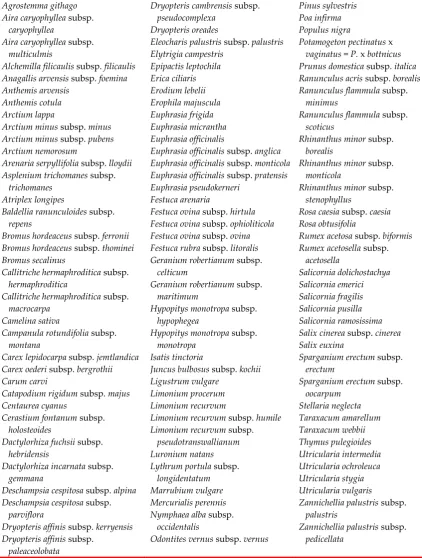Red List No. 10
Ireland Red List No. 10:
Vascular Plants
Michael Wyse Jackson
1, Úna FitzPatrick
2, Edwina Cole
3,
Matthew Jebb
4, Damian McFerran
5, Micheline Sheehy Skeffington
6& Mark Wright
71
National Parks & Wildlife Service, Department of Arts, Heritage, Regional, Rural and Gaeltacht
Affairs, 7 Ely Place, Dublin 2, D02 TW98, Ireland.
2
National Biodiversity Data Centre, Beechfield House, WIT West Campus, Carriganore,
Waterford, X91 PE03, Ireland.
3
An Teachín, Church Road, Ballinacurra, Midleton, Co. Cork, P25 EW71, Ireland.
4National Botanic Gardens, Glasnevin, Office of Public Works, Dublin 9, D09 VY63, Ireland.
5
Centre for Environmental Data and Recording, National Museums Northern Ireland,
153 Bangor Road, Cultra, Holywood, Co. Down, BT18 0EU, UK.
6
BSBI Committee for Ireland, Plant Ecology Research Unit (PERU), Botany and Plant Science,
School of Natural Sciences, NUI Galway, University Road, Galway, H91 REW4, Ireland.
7
Natural Environment Division, Northern Ireland Environment Agency, Department of Agriculture,
Environment and Rural Affairs, Klondyke Building, Cromac Avenue, Belfast, BT7 2JA, UK.
Citation:
Wyse Jackson, M., FitzPatrick, Ú., Cole, E., Jebb, M., McFerran, D., Sheehy Skeffington, M. &
Wright, M. (2016)
Ireland Red List No. 10: Vascular Plants
. National Parks and Wildlife Service,
Department of Arts, Heritage, Regional, Rural and Gaeltacht Affairs, Dublin, Ireland.
Cover photos, from top (photographer):
Hieracium
hartii
(Tim Rich),
Orthilia
secunda
(Neil
Lockhart),
Achillea
maritima
(Michael Wyse Jackson),
Asplenium
septentrionale
(Neil Lockhart),
Trollius
europaeus
(John Conaghan).
Ireland Red List Series Editors: B. Nelson & F. Marnell
© National Parks and Wildlife Service 2016
4
C
ONTENTSEXECUTIVE SUMMARY... 5
ACKNOWLEDGEMENTS ... 6
INTRODUCTION ... 7
Background ... 7
Legal protection ... 8
Priority species/Species Action Plans ... 11
METHODOLOGY FOR DEVELOPMENT OF THE RED LIST ... 12
Nomenclature ... 12
Taxonomic coverage... 13
Status ... 13
Checklist compilation ... 13
Apomicts ... 13
Hybrids ... 13
Geographical coverage ... 14
Data and data sources ... 14
Red List assessment categories and criteria ... 17
IUCN Red List categories ... 17
Regionally determined settings applied ... 18
IUCN Red List criteria ... 19
Application of Red List criteria ... 20
Calculating trends in Area of Occupancy... 21
Calculating trends in Extent of Occurrence ... 22
Application of criterion/subcriterion A3c ... 23
International importance ... 23
Taxa for which Ireland holds a significant proportion of the European population ... 24
Endemics ... 25
European and Global Red Lists ... 26
RESULTS OF ASSESSMENTS ... 26
Summary of Red List assessments ... 26
International importance ... 28
Taxa for which Ireland holds a significant proportion of the European population ... 28
Endemics ... 31
European and Global Red Lists ... 32
FORMAT OF THE RED LIST ... 32
Descriptions of Red List columns ... 32
RED LIST OF IRISH VASCULAR PLANTS ... 35
EXCLUDED TAXA ... 114
5
E
XECUTIVES
UMMARYThis report contains the vascular plant Red List for Ireland. The threat status of native and
archaeophyte (pre-1500 introductions) vascular plant species, subspecies and certain hybrids
recorded from the wild on the island of Ireland is assessed, following current International
Union for the Conservation of Nature (IUCN) categories and criteria, and guidelines for their
application. Vascular plants introduced since 1500 (neophytes) are not assessed. Assessments
are based on records up to 2014 assembled by a group representing government organisations
and biodiversity data centres in both jurisdictions on the island, the Botanical Society of Britain
& Ireland and the National Botanic Gardens, Glasnevin.
Since publication of
The Irish Red Data Book. 1 Vascular Plants
nearly 30 years ago, Ireland has
undergone considerable economic, social and cultural changes, which have affected, to a greater
or lesser degree, the distribution, extent and quality of the semi-natural and other habitats that
support its vascular plant flora. At the same time, this period has seen unprecedented levels of
recording and study of the Irish vascular plant flora, at a variety of scales (Ireland, regional,
county, 10 km x 10 km grid square, site and population) and these data are fully availed of for
the current Red List assessments.
6
A
CKNOWLEDGEMENTS7
I
NTRODUCTIONBackground
The preparation of Red Lists which assess the threat status of species is a commitment in
Ireland’s National Biodiversity Plan for 2011–2016 (DAHG 2011). It is also one of Ireland’s
Global Strategy for Plant Conservation targets. Red List assessment provides information on
the degree to which species are at risk of extinction and, by implication, those for which
conservation measures need to be considered. The results of the Red List assessment contribute
to the assessment of conservation status of habitats and sites, to the process of selecting sites
requiring protection by designation and to the identification of taxa which require protection
under the Flora (Protection) Order and Schedule 8 of the Wildlife (Northern Ireland) Order.
The vascular plants (comprising pteridophytes [ferns and fern allies] and flowering plants
[gymnosperms and angiosperms]) were the first group of species for which an Irish Red List
assessment was undertaken. This work, which assessed the threat status of vascular plants
across the island of Ireland, resulted in the landmark publication,
The Irish Red Data Book. 1
Vascular Plants
(Curtis & McGough 1988). Since then, Ireland has undergone considerable
economic, social and cultural changes, which have affected, to a greater or lesser degree, the
distribution, extent and quality of the semi-natural and other habitats that support its vascular
plant flora, and an up-to-date assessment of the status of its flora is required. This period has
also seen unprecedented levels of recording and study of the Irish vascular plant flora, at a
variety of scales (Ireland, regional, county, 10 km x 10 km grid square, site and population), and
assessments to take account of these newly-acquired data are required. Re-assessment of the
flora is also necessary in order to apply the revised IUCN Red List assessment criteria (IUCN
2001; 2012b; 2016a) including regional guidelines (IUCN 2003; 2012a), developed since the last
assessment, to assign taxa to the appropriate revised Red List categories.
Since 2009, all-Ireland Red Lists have been published as part of a dedicated Irish Red List
publication series by the National Parks and Wildlife Service of the Department of Arts,
Heritage, Regional, Rural and Gaeltacht Affairs (and its predecessors) in collaboration with the
Northern Ireland Environment Agency of the Department of Agriculture, Environment and
Rural Affairs (and its predecessors). For these, Ireland is treated as a single biogeographic unit
and records from all parts of the island are included. This report forms the 10
thRed List
produced for Ireland since 2009. See
http://www.npws.ie/publications
for other published Red
Lists.
8
A number of vascular plants are afforded legal protection in Ireland under domestic and
European law. Sixty-eight vascular plant taxa are protected in the Republic of Ireland under the
Flora (Protection) Order, 2015 (Statutory Instrument No. 365 of 2015) – listed in Table 1
(nomenclature in this, and Tables 2 & 3 below, follows Stace (2011), with names used in the
various legal instruments provided in parentheses). The list of vascular plants in this Order is
the same as that on the Flora (Protection) Order, 1999 (Statutory Instrument No. 94 of 1999), the
only changes to the lists of taxa included in the later Order relating to bryophytes.
Table 1.
Vascular plant taxa listed on the Flora (Protection) Order, 2015
Scientific Name
Scientific Name
Achillea maritima
(
Otanthus maritimus
)
Hypericum hirsutum
Allium schoenoprasum
Inula salicina
Alopecurus aequalis
Lathyrus japonicus
subsp.
maritimus
(
Lathyrus
Arabidopsis petraea
(
Cardaminopsis petraea
)
japonicus
)
Arenaria ciliata
(
Arenaria
ciliata
incl
.
subsp.
hibernica
)
Limosella aquatica
Asparagus
prostratus
(
Asparagus
officinalis
)
Lotus subbiflorus
Asplenium obovatum
subsp.
lanceolatum
Lycopodiella inundata
Asplenium septentrionale
Mentha pulegium
Astragalus danicus
Mertensia maritima
Betonica officinalis
(
Stachys officinalis
)
Minuartia recurva
Calamagrostis epigejos
Misopates orontium
Callitriche truncata
Najas flexilis
Cardamine impatiens
Papaver hybridum
Carex depauperata
Persicaria vivipara
(
Polygonum viviparum
)
Carex divisa
Pilularia globulifera
Centaurium pulchellum
Pseudorchis albida
Cephalanthera longifolia
Puccinellia fasciculata
Clinopodium acinos
(
Acinos arvensis
)
Pyrola rotundifolia
subsp.
maritima
Colchicum autumnale
Sanguisorba officinalis
Cryptogramma crispa
Sarcocornia perennis
(
Arthrocnemum perenne
)
Deschampsia setacea
Saxifraga granulata
Epilobium alsinifolium
Saxifraga hirculus
Equisetum hyemale
x
E. ramosissimum = E.
x
moorei
Saxifraga nivalis
(
Equisetum
x
moorei
)
Saxifraga rosacea
subsp.
hartii
(
Saxifraga hartii
)
Eriophorum gracile
Schoenoplectus triqueter
(
Scirpus triqueter
)
Filago minima
(
Logfia minima
)
Scleranthus annuus
Galeopsis angustifolia
Simethis mattiazzii
(
Simethis planifolia
)
9
Except under licence granted under Section 21 of the Wildlife Act, 1976, as amended by the
Wildlife (Amendment) Act, 2000, none of the taxa listed on the Flora (Protection) Order, 2015
may be taken, damaged, kept, bought, sold or their habitat/environment wilfully altered,
damaged, destroyed or otherwise interfered with. The Wildlife (Northern Ireland) Order 1985,
as amended by the Wildlife and Natural Environment Act (Northern Ireland) 2011, affords a
measure of protection to all wild plants, but sixty-nine species of vascular plant, listed on
Schedule 8, Part 1, are given special protection (Table 2) – without a licence these plants may
not be intentionally picked, uprooted, destroyed, sold, or have their seeds collected and sold.
Two additional species are listed on Schedule 8, Part 2 (
Hyacinthoides non-scripta
and
Primula
vulgaris
) and these are afforded similar protection to those on Part 1, but may be picked (by
authorised persons only) without a licence.
Trichomanes
speciosum
and
Saxifraga
hirculus
, which had been listed on Schedule 8, Part 1 of the
Wildlife (Northern Ireland) Order 1985, were removed from this Schedule under regulation 40
of the Conservation (Natural Habitats, etc.) (Amendment) Regulations (Northern Ireland) 2007
(S.R. 2007/345), their legal protection in Northern Ireland instead being provided by regulation
38 of this Statutory Rule.
10
Table 2.
Vascular plant taxa listed on Schedule 8, Part 1 (except as indicated) of the Wildlife (Northern
Ireland) Order 1985, as amended by the Wildlife and Natural Environment Act (Northern Ireland) 2011
Scientific Name
Scientific Name
Adoxa moschatellina
Hypochaeris glabra
Ajuga pyramidalis
Hypopitys monotropa
(
Monotropa hypopitys
)
Anacamptis morio
(
Orchis morio
)
Juniperus communis
Andromeda polifolia
Limonium binervosum
3Artemisia maritima
(
Seriphidium maritimum
)
Limosella aquatica
Calamagrostis epigejos
Lycopodiella inundata
Calamagrostis stricta
Lycopodium clavatum
Carex bigelowii
Melampyrum sylvaticum
Carex magellanica
Mentha pulegium
Carex pauciflora
Mertensia maritima
Centaurium littorale
Neotinea maculata
Ceratophyllum submersum
Ophrys apifera
Cirsium heterophyllum
Ornithopus perpusillus
Crambe maritima
Orobanche hederae
Cryptogramma crispa
Orthilia secunda
Cuscuta epithymum
Polystichum lonchitis
Dactylorhiza lapponica
1Primula veris
Dactylorhiza traunsteinerioides
(
Dactylorhiza traunsteineri
)
Primula vulgaris
[Schedule 8, Part 2 only]Diphasiastrum alpinum
Pseudorchis albida
Dryas octopetala
Ranunculus fluitans
Eleocharis parvula
Rhynchospora fusca
Epipactis palustris
Rubus chamaemorus
Epipactis phyllanthes
Sanguisorba officinalis
Erica vagans
Saussurea alpina
Erigeron acris
(
Erigeron acer
)
Saxifraga aizoides
Frangula alnus
Saxifraga oppositifolia
Gentianella amarella
Scrophularia umbrosa
Geranium pratense
Silene acaulis
Geranium sylvaticum
Sisyrinchium bermudiana
Gymnocarpium dryopteris
Spiranthes romanzoffiana
Hammarbya paludosa
Teesdalia nudicaulis
Hierochloe odorata
Thalictrum alpinum
Hottonia palustris
Trollius europaeus
Hyacinthoides non-scripta
[Schedule 8, Part 2 only]Vicia orobus
Hyoscyamus niger
Viola persicifolia
Hypericum hirsutum
21Irish plants identified as this are included under Dactylorhiza traunsteinerioides in Stace (2011).
2Recent rcords from Northern Ireland are considered to be erroneous or based on introduced plants/plants of uncertain
native/alien status (Faulkner 2015; McNeill 2010; Northridge et al. 2014).









